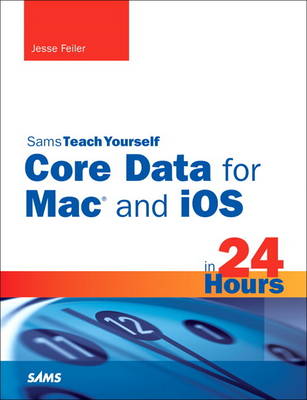Sams Teach Yourself -- Hours
2 total works
In just 24 sessions of one hour or less, start using Core Data to build powerful data-driven apps for iOS devices and Mac OS X computers! Using this book's straightforward, step-by-step approach, you'll discover how Apple's built-in data persistence framework can help you meet any data-related requirement, from casual to enterprise-class. Beginning with the absolute basics, you'll learn how to create data models, build interfaces, interact with users, work with data sources and table views, and even get started with iCloud. Every lesson builds on what you've already learned, giving you a rock-solid foundation for real-world success!
Step-by-step instructions carefully walk you through the most common Core Data development tasks.
Quizzes and Exercises at the end of each chapter help you test your knowledge.
Notes present interesting information related to the discussion.
Tips offer advice or show you easier ways to perform tasks.
Cautions alert you to possible problems and give you advice on how to avoid them.
Learn how to...
- Start writing database apps fast, with Xcode 4's powerful tools and templates
- Master the Objective-C features and patterns Core Data relies upon
- Understand Core Data's goals, components, and behavior
- Model data graphically with Xcode 4's Data Model Editor
- Leverage the full power of Managed Objects
- Use controllers to integrate your data model with your code
- Fetch, use, and store data from any source
- Develop interfaces and features more quickly with Interface Builder
- Add navigation and control features that integrate seamlessly with Core Data
- Interact with users via popovers, segmented controls, action sheets, and tab bars
- Create table views that users can edit
- Let Xcode 4 and Core Data validate your data for you
- Use Predicates to precisely select the right data
- Get ready for iCloud features to sync and move data among your iCloud-enabled devices
Jesse Feiler is a leading expert on Apple database development. Feiler has worked with databases since the 1980s, writing about technologies that have since evolved into Core Data. His database clients have included Federal Reserve Bank of New York, Young & Rubicam, and many small and nonprofit organizations. His recent books include Data-Driven iOS Apps for iPad and iPhone with FileMaker Pro, Bento by FileMaker, and FileMaker Go, and FileMaker Pro in Depth.
Category: Mac Programming
Covers: Core Data
User Level: Beginning-to-Intermediate
Register your book at informit.com/title/9780672335778 for access to all code examples from the book, as well as updates, and corrections as they become available.
In just 24 sessions of one hour or less, you can master the Objective-C language, and start using it to write powerful native applications for both Macs and iOS devices! Using this book’s straightforward, step-by-step approach, you’ll get comfortable with Objective-C’s unique capabilities… make the most of its powerful implementation of objects and messaging…work effectively with design patterns, collections, blocks, threading, and a whole lot more. Every lesson builds on what you’ve already learned, giving you a rock-solid foundation for real-world success!
Step-by-Step Instructions carefully walk you through the most common Objective-C development tasks.
Quizzes and Exercises at the end of each chapter help you test your knowledge.
By the Way notes present information related to the discussion.
Did You Know? tips offer advice or show you easier ways to perform tasks.
Watch Out! cautions alert you to possible problems and give you advice on how to avoid them.
Printed in full color—figures and code appear as they do in Xcode
- Use Xcode to write Objective-C software more quickly and efficiently
- Master Objective-C’s object-oriented features and techniques
- Efficiently organize program files and projects
- Make the most of Objective-C’s powerful messaging capabilities
- Declare classes, instance variables, properties, methods, and actions
- Leverage building block patterns to write more powerful code
- Work with mutable and immutable data types
- Organize data with collections, including dictionaries and sets
- Manage memory the modern way, with Automatic Reference Counting (ARC)
- Expand and extend classes with protocols, delegates, categories, and extensions
- Apply recent language enhancements such as Associative References and Fast Enumeration
- Create and work with portable, anonymous code blocks
- Manage queues and threading with Grand Central Dispatch

